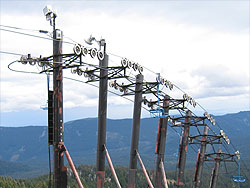
|
|
|
|
Home : Technical : Facts & Figures : Towers : Riblet Sheave Loads Riblet Sheave Loads: By: John Holm & Ryan B Riblet used only four sheaves per tower to allow for steeper tower
angles. Tony Sowder (Doug's father) had a design philosophy wherein
the sheave angle relative to the tower tube was as close to 90 degrees
as possible, so he didn't want a great deal of weight up on the
cap. As Riblet progressed to building triples and then quads, it
became necessary to build towers with eight sheaves due to increased
loads. (I was told by Doug that it would be not impossible, but
difficult to build a six-sheave Riblet assembly.) If you ride Riblets
a lot, you'll notice that the only eight-sheave assemblies are the
newer rectangle-box ones rather than the older squashed-tube or
the really old triangular box. A clarification- I refer to the number
of support or depression sheaves on a tower, not the total including
combo sheaves. There are some Riblet assemblies with a total of
twelve sheaves, but that includes four combo sheaves. Tower 1 on
Baker's C-8 has a combo with 16 depression and 8 support- the most
I've seen on any lift. To add to John's post, I belive Riblet got hit pretty hard on a code addition in the early 80s. "One sheave per degree of angle change". Riblet did have a large artistic design license with this issue. Four sheave design per tower was self governing. He needed bigger components to allow for larger angles. Design did evolve later to include larger angles and loads. In each area there are given limits and recommendations for corrections if the limit is exceeded. Haul rope actual safety factor in ski lifts is quite high compared to other wire rope uses. To my knowledge no haul rope has broken while in normal use at a ski area. In wire rope industry (which ski industry is a part of) there is a correlation between sheave diameter and suggested degree of maximum angle change. Load force is perpendicular to the haulrope. Riblets "lighter design" dictates tower must be perpendicular to haul rope. This also includes sheave assemblies and cross arms. "Beefier" designs have more latitude with placement. It should be noted that both types of design are well above any structural failure. Also both types have to resist deflection as the first criteria in their design. The only way Riblet can do this by angled tower placement. - Ryan B |
Home : About Skilifts.org : Donate : Privacy Policy : Terms of Use
All logos and trademarks on this site are property of their respective owner.
© Copyright 2002-2004 by Skilifts.org -- All Rights Reserved.
Hosted by NW-Hosting.com